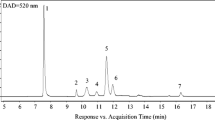Abstract
The effect of crude polyphenols (CLP) from cacao liquor on vitamin F-deficient rats was examined. The CLP fraction contained 49.8% antioxidative polyphenols such as catechins and their oligomers. Supplementation of the vitamin E-deficient diet with CLP for 7 wk did not prevent the decrease in α-tocopherol levels in the liver, kidney, heart, brain, and plasma. The lipid peroxide levels in these tissues increased in the group fed the vitamin F-deficient diet compared with the control group. However, these changes were inhibited in a dose-dependent manner as a result of supplementation of the vitamin E-deficient diet with 0.25, 0.5, or 1.0% CLP. The lipid peroxide levels in plasma increased in the group fed the vitamin E-deficient diet. This change tended to be suppressed as a result of supplementation of the diet with CLP, but the difference was not significant. There was no evidence of absorption and distribution of CLP to the tissues; however, CLP intake resulted in a decrease in oxidative stress without maintaining vitamin E levels in the plasma and the tissues.
Similar content being viewed by others
Abbreviations
- CLI:
-
cacao liquor crude polyphenols
- EC:
-
epicatechin
- PMC:
-
2,2,5,7,8-pentamethyl-6-chromarol
- TBARS:
-
thiobarbituric acid-reactive substances
- VE:
-
vitamin E
References
Hertog, M.G.L., Feskens, E.J.M., Hollman, P.C.H., Katan, M.B., and Kromhout, D. (1993) Dietary Antioxidant Flavonoids and Risk of Coronary Heart Disease: The Zutphen Elderly Study, Lancet 342, 1007–1011.
Hertog, M.G.L., Feskens, E.J.M., and Kromhout, D. (1996) Antioxidant Flavonols and Coronary Heart Disease Risk, Lancet 349, 699.
Knekt, P., Jarvinen, R., Reunanen, A., and Maatela, J. (1996) Flavonoid Intake and Coronary Mortality in Finland: A Cohort Study. Br. Med. J. 12, 478–481.
Fukuda, Y., Nagao, M., Osawa, T., and Namiki, M. (1986) Contribution of Lignan Analogues to Antioxidative Activity of Refined Unroasted Sesame Seed Oil. J. Am. Oil Chem. Soc. 63, 1027–1031.
Matsuzaki, T., and Hara, Y. (1985) Antioxidative Activity of Tea Leaf Catechins, Nippon Nogeikagaku Kaishi 59, 129–134.
Tebib, K., Rouanet, J.M., and Besançon, P. (1997) Antioxidative Effects of Dietary Polymeric Grape Seed Tannins in Tissues of Rats Fed a High Cholesterol-Vitamin E-Deficient Diet, Food Chem. 59, 135–141.
Forsyth, W.G.C., and Roberts, J.B. (1960) Cacao Polyphenolic Substances 5. The Structure of Cacao Leucocyanidin, Biochem. J. 74, 374–378.
Kim, H., and Keeney, P.G. (1984) (-)-Epicatechin Content in Fermented and Unfermented Cocoa Beans, J. Food. Sci. 49, 1090–1091.
Porter, L.J., Ma, Z., and Chan, B.G. (1991) Cacao Procyanidins; Major Flavonoid Identification of Some Minor Metabolites, Phytochemistry 30, 1157–1663.
Sanbongi, C., Osakabe, N., Takizawa, T., Gomi, S., and Osawa, T. (1998) Antioxidative Polyphenols Isolates from Theobroma cacao. J. Agric. Food Chem. 46, 454–457.
Osakabe, N., Yamagishi, M., Sanbongi, C., Natsume, M., Takizawa, T., and Osawa, T. (1998) The Antioxidative Substances in Cacao Liquor, J. Nutr. Sci. Vitaminol. 44, 313–321.
Hamerstone, J.F., Lazarus, S.A., Mitchell, A.E., Rucker, R., and Schmitz, H.H. (1999) Identification of Procyanidins in Cocoa (Theobroma cacao) and Chocolate Using High-Performance Liquid Chromatography/Mass Spectrometry, J. Agric. Food Chem. 47, 490–496.
Ueda, T., and Igarashi, O. (1987) New Solvent System for Extraction of Tocopherols from Biological Specimens for HPLC Determination and the Evaluation of 2,2,5,7,8-Pentamethyl-6-chromanol as an Internal Standard, J. Micronutr. Anal. 3, 185–198.
Price, M.P., and Butler, L.G. (1977) Rapid Visual Estimation and Spectrophotometric Determination of Tannin Content of Sorghum Grain, J. Agric. Food Chem. 25, 1268–1273.
Ricardo da Silva, J.M., Rigaud, J., Cheynier, V., Chemina, A., and Moutounet, M. (1991) Procyanidin Dimers and Trimers from Grape Seeds, Phytochemistry 30, 1259–1264.
Mino, M., Kitagawa, M., and Nakagawa, S. (1981) Changes of Alpha-Tocopherol Levels in Red Blood Cells and Plasma with Respect to Hemolysis Induced by Dialuric Acid in Vitamin E-Deficient Rats. J. Nutr. Sci. Vitaminol. 27, 199–207.
Ohkawa, H., Ohishi, N., and Yagi, K. (1979) Assay for Lipid Peroxides in Animal Tissues by Thiobarbituric Acid Reaction, Anal. Biochem. 95, 351–358.
Lowry, O.H., Roschrough, N.J., and Randall, R.J. (1951) Protein Measurement with Folin Phenol Reagent, J. Biochem. 193, 265–275.
Piskula, M.K., and Terao, J. (1998) Accumulation of (-)-Epicatechin Metabolites in Rat Plasma After Oral Administration and Distribution of Conjugation Enzymes in Rat Tissues. J. Nutr. 128, 1172–1178.
Chow, C.K. (1992) Oxidative Damage in the Red Cells of Vitamin E-Deficient Rats, Free Radical Res. Commun. 16, 247–258.
Yamashita, K., Nohara, Y., Katayama, K., and Namiki, M. (1992) Sesame Seed Lignans and γ-tocopherol Act Synergistically to Produce Vitamin E Activity in Rats, J. Nutr. 122, 2440–2446.
Yamashita, K., Iizuka, Y., Imai, T., and Namiki, M. (1995) Sesame Seed and Its Lignans Produce Marked Enhancement of Vitamin E Activity in Rats Fed a Low α-Tocopherol Diet, Lipids 30, 1019–1028.
Jenkins, K.J., Collins, F.W., and Hidiroglou, M. (1992) Efficacy of Various Flavonoids and Simple Phenolics in Prevention of Nutritional Myopathy in the Chick, Poultry Sci. 71, 1577–1580.
Jenkins, K.J., Hidiroglou, M., and Collins, W. (1993) Influence of Various Flavonoids and Simple Phenolics on Development of Exudative Diathesis in the Chick, J. Agric. Food Chem. 41, 441–445.
Richelle, M., Tavazzi, I., Enslen, M., and Offord, E.A. (1999) Plasma Kinetics in Man of Epicatechin from Black Chocolate, Eur. J. Clin. Nutr. 53, 22–26.
Hollman, P.C., Tijburg, L.B.M., and Yang, C.S. (1997) Bioavailability of Flavonoids from Tea, Clin. Rev. Food. Sci. Nutr. 37, 719–738.
Baba, S., Osakabe, N., Natsume, M., Yasuda, A., Takizawa, T., Nakamura, T., and Terao, J., Cacao Liquor Enhances Antioxidative Ability of Rat Plasma, Br. J. Nutr., in press.
Author information
Authors and Affiliations
Corresponding author
About this article
Cite this article
Yamagishi, M., Osakabe, N., Takizawa, T. et al. Cacao liquor polyphenols reduce oxidative stress without maintaining α-tocopherol levels in rats fed a vitamin E-deficient diet. Lipids 36, 67–71 (2001). https://doi.org/10.1007/s11745-001-0669-9
Received:
Revised:
Accepted:
Issue Date:
DOI: https://doi.org/10.1007/s11745-001-0669-9




